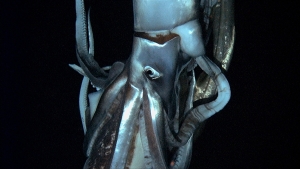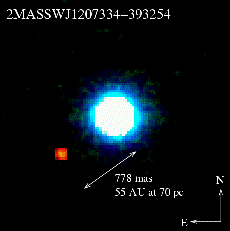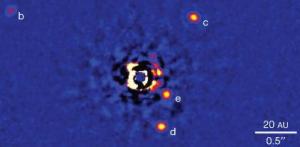
Giant squid finally caught on video
It was recently announced that Japanese scientists have managed to finally capture video footage of a giant squid. We’ve known for some time that they exist, but until now, they have never been seen like this in their native environment.
Previously discussed detection methods for extrasolar planets leave much to be desired. Doppler spectroscopy tells you only a minimum mass for the planet and its orbital period. Transit photometry tells you the size and orbital period of the planet, and is typically not capable of confirming the detected object as a planet (since the mass is unknown, a brown dwarf or low-mass star could masquerade as a planet). Gravitational microlensing tells you the planet’s mass but only a projected distance from the star, and usually nothing about the orbit. Astrometry tells you the planet’s true mass and orbit in three dimensions, but otherwise permits you no more information about the planet than Doppler spectroscopy. Combining these techniques will allow one to tease out more information, but it’s still awfully indirect. We know the planets are out there, but it would be nice to actually see them.
The ultimate detection method of the future that will provide the most information is direct imaging. It’s very straightforward, all it involves is a large telescope with a decent imaging contrast ratio. It sounds easy but there are daunting challenges involved due to the proximity of planets to their stars and the brightness of their host stars.

The first directly imaged exoplanet
As of the time of this writing, only a couple dozen or so planets have been imaged with 8 – 10 metre class telescopes as well as HST. For the most part, they were all imaged in the infrared, they are all very massive as far as planets go, and they are all widely separated from their stars – typically hundreds of AU.
The greatest problem is that stars are very bright, and planets are comparatively very dim. In visible light, there’s a brightness contrast between the Sun and Jupiter of a factor of a billion, but depending on the wavelength and system age and planet mass, the brightness contrast can be as low as ten thousand. This problem is made worse by the diffraction of the starlight across the focal plane of the telescope produces a large amount of “noise,” with the star’s light spread out over a greater area of the image. A method of removing this excess light from a star is a requirement for directly imaging its planets.
One method of doing so is to use a coronograph. This is effectively an object in the telescope to block the light from the star, allowing one to see “around” the star. While you might therefore expect there to be dark “hole” in the image where the star is, the diffraction of light around the coronograph still produces a brighter, noisy area where the star would be. Imperfections in the coronograph will result in extra noise, and it is not clear that perfect coronographs are achievable. Since coronographs (even perfect ones) only attenuate the coherent part of the light’s wavefront (the shape of the waves of light). Imperfections in the wavefront (called aberrations) can leak through the coronograph to produce a residual noise in the form of a speckled halo around the star. Methods exist to correct this, such as wavefront correction with deformable mirrors or to calibrate images for speckles. It’s not perfect, but it certainly removes a lot of the excess starlight.

Four planets at HR 8799
Some caution is necessary when discovering planets through direct imaging. A supposed planet next to a star could turn out to be a background star. Monitoring of the planet candidate over some time will be needed to determine if it is bound to the star. Since stars and their associated planets move through space together, there is a certain motion in the sky that the planet and the star will follow if they are bound, whereas the two will have vastly divergent motions in the sky if they are not.
The advantages of directly imaging extrasolar planets is beyond having pictures – it permits direct spectroscopy of the planet’s light. Now while it is possible to gather information about the atmosphere of a transiting planet at a great distance from the star, the fraction of planets at large distances from their star that will transit are quite low. Direct imaging opens up access to all planets with a sufficient brightness and angular separation from the star.
I suspect in the future that this will be the most prevalent way of truly characterizing the planets in the solar neighborhood. Statistically speaking, few nearby Earths will transit, so we will require direct imaging to test their atmospheres for the presence of bio-markers that may be indicative of life.